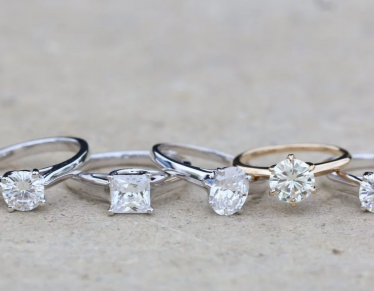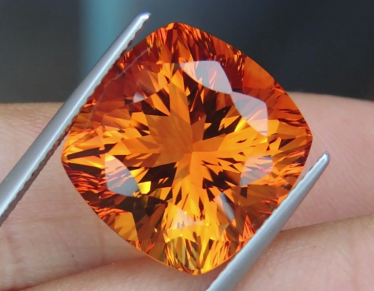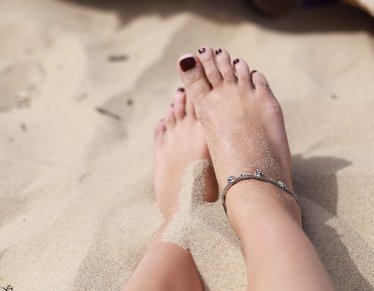We all know what happens to sterling silver, and in fact, dealing with tarnished silver may have been a reason why you decided to switch over to gold jewelry.
Cleaning tarnished sterling silver can be a bit of pain, especially if you find some pieces that haven’t been polished in a while. The switch would make sense because, after all, gold doesn’t tarnish. Right?
Many people believe that gold doesn’t tarnish and that it requires basically zero maintenance for keeping it looking clean and shining. Is that true? It certainly is, but it is a bit of a misleading statement.

There is much more to the idea of gold not tarnishing, and we want to clear up all the potential misinformation out there so that you can be well informed when purchasing jewelry, as well as maintaining it. There are certain best practices for cleaning gold, just as there is for silver.
Let’s discuss what tarnish is instances where gold may tarnish, as well as how to keep your gold jewelry nice and clean.
You’ll be happy to know that gold does typically require less maintenance than silver, but that doesn’t mean you are free from any maintenance.
What is Tarnish?
Before we get into if gold tarnishes, it makes sense first to explain what tarnish is.
Tarnish is a type of corrosion that occurs when certain metals come into contact with a nonmetal substance, typically oxygen, or sometimes sulfur dioxide.
What is happening is essentially a chemical reaction between the metal and the substance. Oxidation is what occurs and causes the dark and muted discoloration that you can probably picture.
Most commonly, this type of tarnish occurs in sterling silver, copper, and brass. These metals are ‘reactive’, meaning that when they are in contact with the nonmetal substance, the reaction occurs.
Notice that we didn’t mention gold in that list? Good eyes! Now to answer the burning question in your mind, does gold tarnish?
Does Gold Tarnish?
Like we hinted at earlier, no! Pure gold does not tarnish. In fact, gold is one of the least reactive elements, meaning it will not experience that type of chemical reaction when exposed to oxygen. This is also true for platinum and rhodium.
The keyword there is pure. Solid 24k gold will absolutely not tarnish, but when is the last time you saw a piece of jewelry that was 24k solid gold? Likely never.
Not only would 24k gold jewelry be incredibly expensive, but it also wouldn’t be durable at all. Solid gold is incredibly soft and is not a smart choice of metal when creating jewelry.
Therefore, the overwhelming majority of gold jewelry you will find will be some type of mixture or alloy of metals that will be majority gold but mixed with things like copper, silver, or nickel.
To understand how much gold is present in a piece of jewelry, you look at the karat amount. 24 karat gold is pure gold. Anything else is a percentage of that. For example, 18 karat gold means that 18/24 is gold or 75%.
With that in mind, here is a really easy chart that will help you understand how much gold is in the common karat amounts:
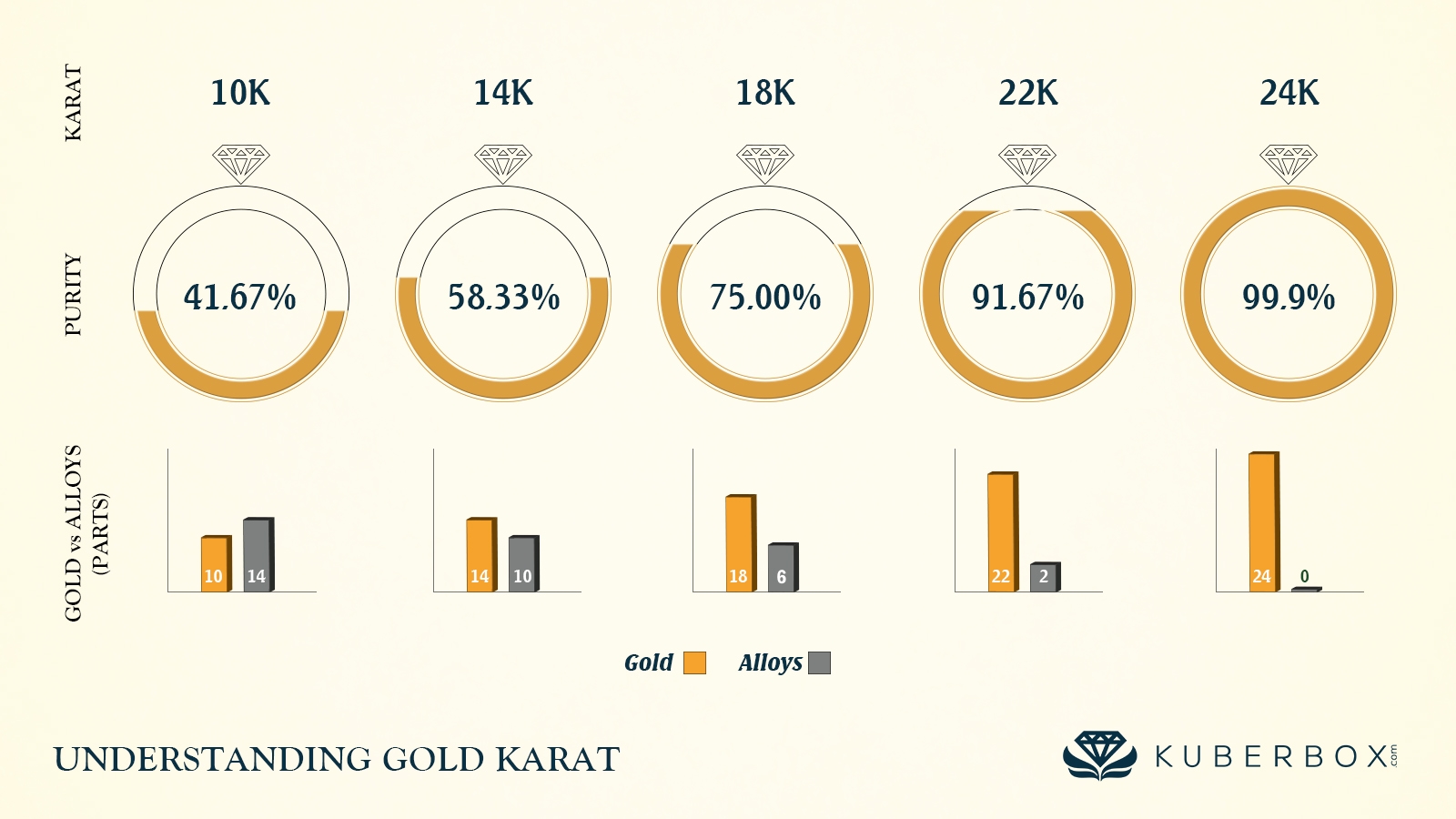
Clearly, the higher the karat you have, the more gold you have, and the fewer alloys are present. The higher karat you’ve got, the less chance you will experience any tarnishing.
Typically, gold jewelry that is 18k or higher will not experience much tarnishing, as the overwhelming majority of the jewelry is, in fact, gold.
You may start to experience some tarnishing with 14k gold and can definitely expect to see some with 10k gold.
It is those alloyed metals like silver, nickel, or copper that are causing the tarnish, not the gold itself.
If you do want gold jewelry that will not require a lot of maintenance, we recommend going with at least 18k gold.
Keep in mind that the higher karat you go, the more expensive the jewelry is going to be. You will have to decide if cost or maintenance is more important to you.
A Quick Note about Platinum and Rhodium
Earlier, we mentioned that platinum and rhodium also do not tarnish. Rhodium, similarly to solid gold, is not a good option for solid jewelry as it is too brittle and not easily shaped (as opposed to solid gold, which is too soft). Check out our complete guide to rhodium for more information.
Platinum also does not tarnish, but it is also incredibly expensive. However, if you do not like the appearance of gold and prefer the silver appearance but do not want to deal with tarnishing, we recommend either going with platinum or getting your jewelry rhodium plated.
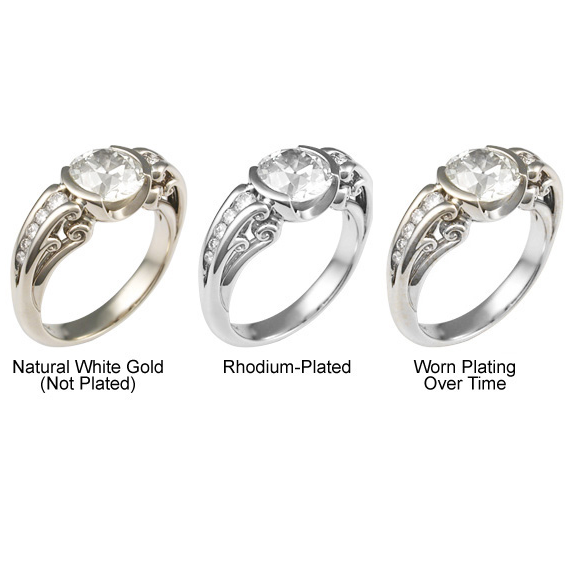
The plating will have to be re-done from time to time, but it will cost you less than platinum and will ensure your jewelry always looks shiny and brand new.
Now back to gold! If you do have gold that is lower than 18k quality, you will want to clean it to prevent or clear up any tarnishing. Let’s discuss the best ways of cleaning your gold.
Preventing Tarnish
One of the best ways to ‘clean’ your gold is to keep it from tarnishing in the first place! While there is no way to prevent tarnish completely with lower karat amounts of gold, you can take care of it to prevent a lot of it.
Technically, you could keep the gold tarnish free by storing it properly and never wearing it, but then what would be the point of owning it?
Jewelry is meant to be worn, but as a result, the jewelry will be in contact with your skin and with air. This is what will be the main cause of tarnish.
In fact, everyone has unique body chemistry, and you will find that some people’s skin will cause jewelry to tarnish faster than others. Fascinating!
There is nothing you can do in this case, but it is just something to be aware of. If you realize that your body chemistry does cause jewelry to tarnish quicker, consider either wearing the jewelry less frequently or upgrading to higher karat gold or another metal like platinum.
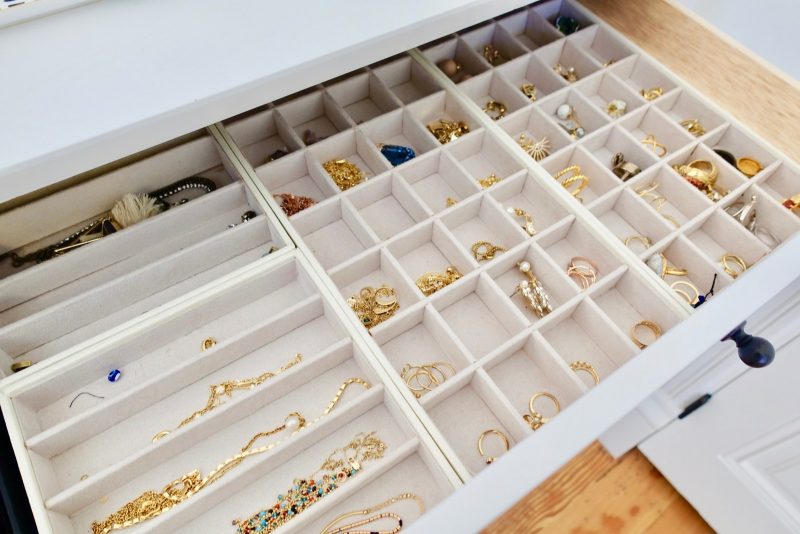
Another main step for preventing tarnish is with regards to how you store the jewelry. Keeping it out in the open and exposed to air is a major way that gold will tarnish. Don’t do that!
Any jewelry that has the potential to tarnish should be kept in a box or pouch or a similar item that will keep the jewelry from being exposed to the elements that cause tarnishing (mainly- oxygen).
Thankfully, there are plenty of jewelry containers that are designed for this exact purpose. We recommend using a jewelry specific container so that you can be sure the container doesn’t have certain fabrics or materials that contain sulfur, as sulfur compounds like sulfur dioxide can cause tarnishing as well.
How to Clean Gold
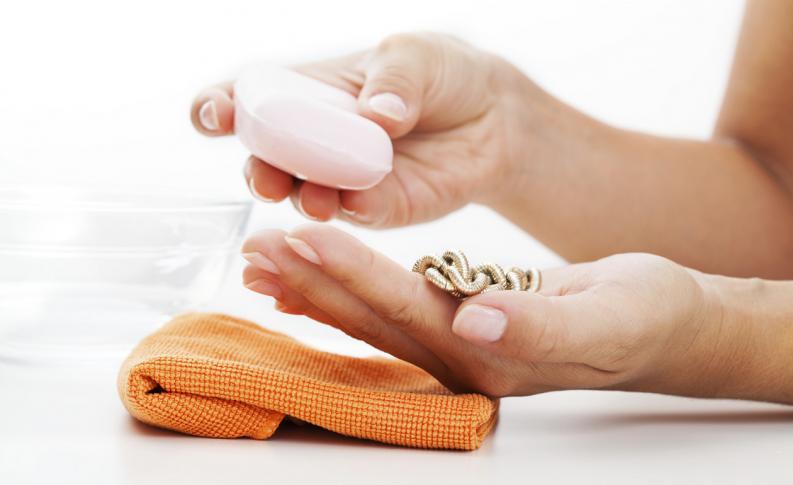
When you do want to (or have to) clean your gold, you will want to make sure you are careful to not damage or scratch the gold.
While the lower karat amount will mean that the piece is more durable, you are still dealing with a significant percentage of gold, which can easily scratch since it is such a soft metal.
You also do not want to use any cleaners that are too abrasive. These can cause scratches or damage, as well.
Your jeweler may have a prepared solution that is created specifically for gold jewelry, but if not, there are simple products you have at home that should work just as well!
We recommend using lukewarm water and mild dish soap. You do not want a heavy-duty soap, as it contains chemicals that can damage the jewelry. Stick with something mild like Dawn and just use a few drops.
You can leave your jewelry in the water and soap mixture for around 10 or 15 minutes. Remove from the water and then use a soft-bristled toothbrush to remove any remaining tarnish or even dirt that might be present.
If you want to use something more gentle, consider using something like a cotton swab to clean the jewelry.
Once you are done cleaning it, rinse it off in warm water to get all the soap completely removed and then let it dry completely before wearing it or storing it away.
We recommend using a soft cloth to dry it completely and then putting it away. You can also let it air dry if you prefer. That’s it!
Wrapping Up
While it is technically true that gold does not tarnish, you more than likely have jewelry in your collection that is not solid gold. Therefore, the alloy of metals present may cause the jewelry to tarnish over time.
If you do not want to deal with tarnishing, be sure to get 18k or higher quality gold, or go with a white metal like platinum (or opt for rhodium plating).
Store your jewelry properly so that it is not regularly exposed to the air. When it does come time to clean it, use warm water and mild soap. Any tarnish should come off pretty easily!
Taking care of gold jewelry is not all that difficult; you just have to have the right information so that you know what you need to do.
Now that you know everything, you are well prepared to care for all your existing, and future, gold jewelry!

